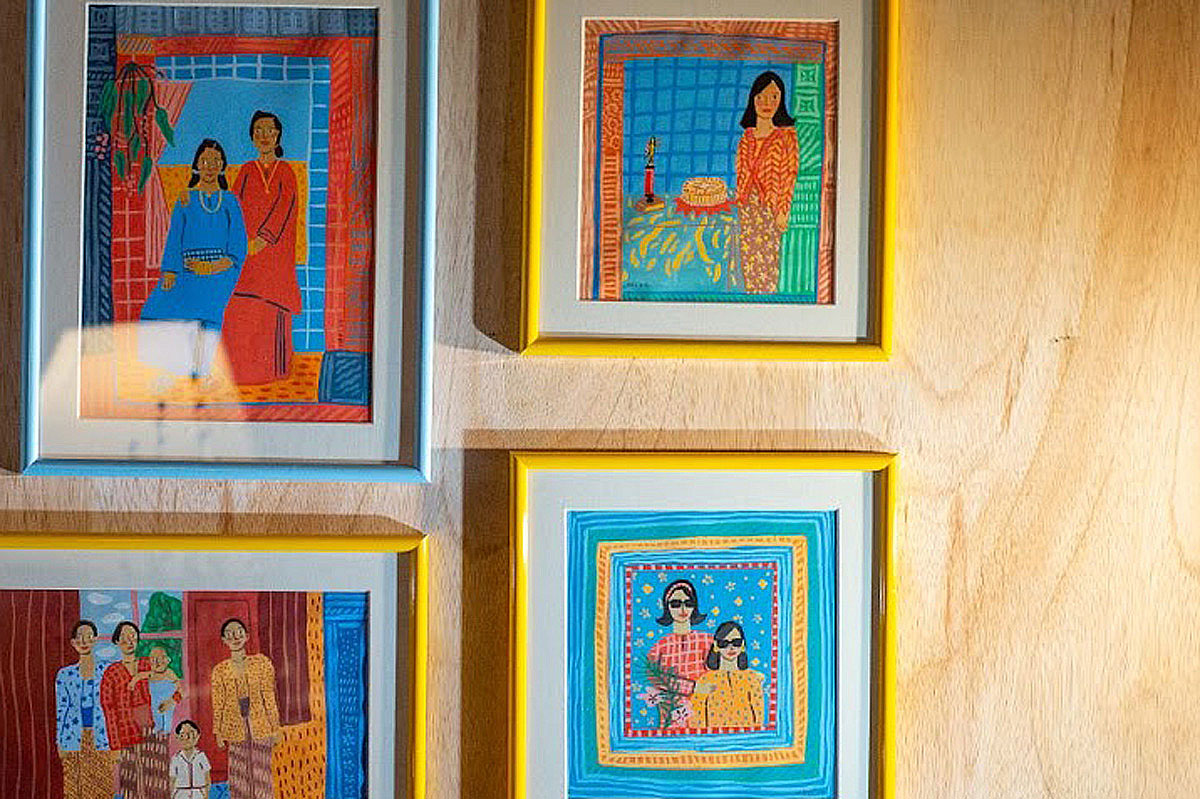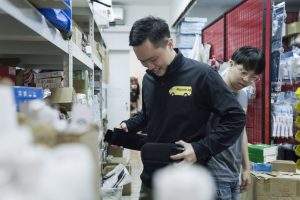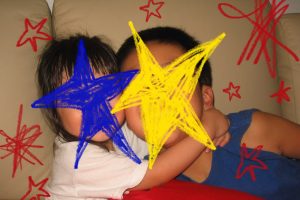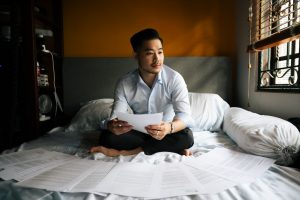Top image: Supper House, ‘Nyai-Nyai Ayu’, 2022, by Hafizah Jainal
All other images: Cam Khalid
DNA tests seem like harmless fun when it comes to exploring one’s background. You spit into a vial, send it off for analysis and wait for the lab to unlock the mystery of your genomes.
Plus, what says you’re “special” more than getting right down to the crux of genetics?
ADVERTISEMENT
Growing up, my Malay-Buginese parents and grandparents told me that I was of mixed heritage, with ancestors primarily from Malaysia and Indonesia. However, this was never really confirmed on paper. My NRIC simply states ‘Malay’, which is as vague as it gets.
For years, I would make up exotic-sounding combinations to justify my racially ambiguous appearance or give people a run for their money for guessing my ethnicity. In the West, strangers direct spit rapid-fire Spanish at me. Once, a friend of a friend was talking about the Colombian conflict, pointed at me and verified his guess: “You’re Colombian, right?”
Even in Singapore, my own Motherland, there’s no escaping it. Filipinos and even locals have asked me if I was from the Philippines.
I was curious to know if there were more branches to my family tree beyond what I was told: Malay, Bugis, Chinese, Indian and Dutch. If so, in what proportion? A DNA test would shed light on my genetic story and answer the ubiquitous “Where are you from?” question.
However, the idea of surrendering my spit to a DNA-testing company sounded a little intimidating to me. In a world where data protection is key, such tests pose certain privacy risks, such as how test companies store and use information.
Besides privacy, there’s also the emotional fallout of receiving life-changing results. What if there were dusty skeletons in the family closet? What if my grandparents were wrong about their ancestors?
Singapore has been a melting pot for generations, and it’s no surprise that many individuals have mixed backgrounds that some don’t even know about. Naturally, many younger Singaporeans are submitting to the £7.7 billion (SGD 13.7 billion) industry that promises to tell them who they are—feeding their curiosity about their racial background beyond what is written on their NRICs.
A family affair
I never thought I’d see the day when I would sit at the kitchen table, spitting into a test tube in the spirit of scientific inquiry. But alas, curiosity (and a generous 50 per cent discount) got the better of me.
I went ahead with Ancestry, which boasts to be “the world’s largest online family history resource.” It claims to have more than 20 million participants worldwide, which gives the potential for very rich data, covering six world regions, including Africa, America, Asia, Europe, Oceania, and West Asia.
Almost eight weeks later, I pulled up the results from my laptop with my heart pounding. I scanned the digital map and was surprised to discover that I was more Filipino (Northern and Southern) than Indonesian or Malay (Western Indonesia and Peninsular Malaysia)—making up almost 50 per cent of my DNA.
My imagination ran riot. Did someone in my family have an affair? Or is it all because of the Southeast Asian diaspora? I had more questions than answers.
I questioned my mum, whose only explanation was: “Maybe it’s because our ancestors came from Sulawesi, which is close to the Philippines.”
In other words, she has no idea where those Filipino genes came from, but she could be right. Sulawesi is surrounded by the Philippines to the north. But wouldn’t Sulawesi still be considered Indonesia, and if not part of Western Indonesia, maybe Central Indonesia, instead of being lumped together with Southern Philippines? Ancestry, I need answers.
ADVERTISEMENT
A similar shocking revelation was also experienced by visual artist Hafizah Jainal who chose MyHeritage for its extensive Southeast Asian data pool.
“I have always been interested in ancestral narratives. What are the stories of the women who came before me?” she said. “This somehow trickled down into the themes of my artworks.”
Recently, Hafizah exhibited a personal installation as part of Veneer and Visage. It featured illustrations, archival photos and vintage fashion in memory and honour of her late nyai (grandmother).
“I know that my maternal side of the family came from Malacca. My grandparents migrated to Singapore after my grandad got a job offer here. My paternal side of the family came from Indonesia. My grandfather was from Pacitan and migrated to Singapore. He married my grandma, who was born in Singapore and whose parents were Javanese,” she shares.
“Naturally, I thought my DNA pool would be predominantly Indonesian and Malay.”
Hafizah’s results revealed otherwise. She is 57 per cent Thai and Cambodian, and 49 per cent Filipino, Indonesian and Malay. “I was surprised more than anything else and also confused. I’ve never identified with being Thai or Cambodian at all.”
“I felt like a total imposter—here I am identifying as a Javanese, which is the race stated in my IC because it’s the culture I grew up with. But it also made me aware that there was so much human migration in Southeast Asia and the Nusantara (Malay Archipelago).”
“I can only speculate that my paternal grandfather might be the one with Thai and Cambodian ancestry, whose family decided to settle in Pacitan (a town in East Java), assimilate themselves with local culture, and identify as Javanese.”
Hafizah’s interest in her late grandfather has since heightened. Beyond the test results, she intends to delve deeper through conversations with her extended family.
ADVERTISEMENT
When asked if she would seek answers in his hometown, she says, “I don’t have the urge to travel to his hometown for now because I feel that there are still many people here whom I have yet to speak to regarding my late grandfather.”
There were even more surprises when Hafizah’s remaining two per cent turned out to be Baltic and Finnish. This led her to dig even further into her family tree, in which she discovered that her great grandfather’s name was Eljas—a name that even her dad pointed out was uncommon for a Javanese person. “After much Googling, I found out that the name is of Finnish origins.”
Like many of us, Hafizah’s family histories were handed down verbally from generation to generation. “It’s a bit hard for me to investigate when all I have are archival family photographs and verbal history from a huge bulk of my family who are getting older and disappearing.”
Graphic designer Natasha Hassan also succumbed to MyHeritage to determine where her paternal grandfather came from and the sub-ethnic group he belonged to. “He was an Indian and Pakistani migrant, but he passed away when I was young. I wanted to know more about his culture.”
Though Natasha’s results determined she had Indian ancestry, she felt somewhat disappointed by the lack of breakdown. Instead of having sub-ethnic groups, ethnicities such as Southern Indian, Sri Lankan, Malaysian and Singaporean were classified under one big group: South Asian.
“I realised these DNA companies lack data for Asian and indigenous parts of the world,” she said. “I may be wrong now as it’s been a few years since I did the test. Perhaps more data has been collected globally, and they can give a more accurate geographical migration map for anyone who tries it now.”
Although she hadn’t managed to do much with the information she received, she still feels proud and appreciative of her roots.
“I always wonder if I’m Indian or Malay enough—the struggles of being biracial,” she says. “Regardless of whether I practice these cultures, my DNA defines my identity.”
More than revealing long-lost ancestry
Besides learning about your ancestry by pie-chart percentage, DNA tests also provide significant insights into your health, from how you digest and absorb nutrients to finding out how your skin is likely to age, all the way down to aspects of your personality like empathy and obsessive-compulsive behaviour.
For years, people from different ethnic makeup have been lumped into a single group, leaving them underserved medically.
“By taking into account a person’s ancestral lineage and analysing them as a unique individual, we have been able to pull out information which may have been buried when looked at as one giant population,” says Dr David Klinzing, General Manager and Chief Technology Officer of Imagene Labs, the Singapore-based company behind Ori DNA tests.
Due to local Ministry of Health (MOH) regulations, most DNA tests in Singapore, including those offered by Imagene Labs, are non-diagnostic. They can only provide insights into an individual’s predispositions. Such genetic assessments can help individual consumers, as well as healthcare practitioners and wellness affiliates. Even policymakers can use the information to craft more accurate, targeted, personalised, and effective strategies.
Marketing executive Angelina Chang signed up for a detailed health check with CircleDNA to discover her predispositions and ancestry. “I wasn’t aware of any health issues that I may have or am prone to have, so I decided to do the test to know what’s in my DNA.”
“It’s interesting because you get to know quite a few things, not just about health,” she continues. “You also learn about your ancestry, sports performance, and personality.”
With her health results, Chang reflected on her lifestyle choices and made positive changes that will improve her health. On the other hand, her personality results had a more profound effect. She got to learn about how her DNA plays a role in how she perceives people and things around her. The only way forward is to “educate [herself]” and “be more open,” she says. When it comes to her ancestral lineage, she was surprised to find she is 25% Japanese and Korean.
How it works
When asked about the nitty-gritty of analysing DNA, Dr Klinzing explains that our DNA is built with four bases — Adenine (A), Thymine (T), Guanine (G), and Cytosine (C). “The genome in all humans is almost the same, with minor variations between individuals.
In a case where a ‘single letter change’ occurs in the DNA sequence — for example, where someone has an ‘A’, another person has a ‘G’ — this is known as a Single Nucleotide Polymorphisms or SNP.”
Pronounced “snip”, SNPs can be responsible for physical traits like hair type or eye colour and susceptibility to health conditions and responses to medication.
When an individual’s saliva sample arrives at the lab, the DNA is extracted and put through microarray analysis. “Microarray analysis allows us to quickly detect thousands of SNPs and how they are expressed in your DNA,” Dr Klinzing adds.
“Your resulting gene data is then compared against the most ethnically-relevant reference genetic dataset. Our bioinformatics calculates your predispositions into a report that explains your likelihood for a particular trait and personalised lifestyle, exercise, nutrition, and supplement or product recommendations.”
However, the reference group each company uses can be different, and reference groups are changing all the time depending on the number of samples the company has tested.
According to researchers at 23andMe, it is worth noting that “ancestry, ethnicity, identity and race are complex labels that result both from visible traits, such as skin colour, and cultural, economic, geographical and social factors.”
Researchers can identify the continents in which the DNA sequences originated. However, narrowing it down to a particular country or area is far trickier if they don’t have a good data set of the genetic characteristics of that specific place.
At the end of the day, they’re looking for the best fit, not a perfect match.
Privacy risks
DNA testing has been used in medical and scientific contexts since its discovery in the 1860s. Direct-to-consumer testing kits, however, are still considered relatively new. This means that the legal policies that govern the private use of consumer data are still being developed.
“Where many consumers might have concerns on privacy, [the team at Image Labs] is proud that our system is already used by partners in the U.S. and E.U., so our platform already complies with international data management. And being a Singapore founded company, we comply with our local Personal Data Protection Act (PDPA) as well,” assures Dr Klinzing.
It’s a no brainer to read the privacy FAQs of the DNA companies before handing over your DNA sample. Most companies are transparent about sharing data with third parties such as pharmaceutical companies, insurance companies, and law enforcement agencies.
Legal policies are still in the works globally, so terms and conditions can change. Because of this, some companies allow you to withdraw your consent at any time. The downside? Your withdrawal usually takes time to come into effect, and by then, your data may have already been passed on, making it difficult to track. Plus, there’s no guarantee that those third parties won’t also share your data down the road.
If the small print isn’t enough to convince you to trust the company with your DNA, then the best advice is to give the test a miss.
DNA ancestry isn’t the same as heritage
The thing about DNA testing is that despite helping users learn more about their ancestry, the genetic connection—and even ethnic identity—is far more complicated than the industry lets on.
A few days after I received my results, I tried piecing my heritage through my features but to no avail. Our cultural background and identity define who we think we are, and when I received my results, I felt that modern genetics has somehow challenged those notions.
Before the test, I had no cultural knowledge of the Philippines. I’ve always assumed to be more Bugis than anything else. Now that I’ve learned that most of my DNA makeup comes from the Philippines, does that mean I should start claiming it as my own too?
The more I think about it, the more I realise that there are various ways I can embrace all aspects of my ancestry. It’s in the food we eat, the music we listen to, the stories we tell, and even the language we speak.
Due to human history being a messy, migratory affair, it’s not easy—or even wise—to take DNA results at face value.
Family histories aren’t clear-cut geographic, and DNA ancestry isn’t the same as race or heritage. As a Malay growing up in Singapore, I often felt race undermined me. As long as you’re a certain race, you’re immediately labelled with a stereotype—whether it’s being lazy or smelly. Thanks to social media, the issue of xenophobia and racism in Singapore has been exposed as a grave problem that needs to be tackled.
I remember a classmate once pointed out: “You’re not like all the other Malays because you’re mixed.” This reeks of racism, but back when I first heard it as a teenager, it sounded like she intended it to be a compliment. It made me feel conflicted as I was glad I didn’t fit the stereotype, but at the same time, I was very much proud of being Malay.
Regretfully, I didn’t fault her.
Stereotypes, like those about race, are social constructs. They have nothing to do with our genetic makeup. If they would be, then we’d all be living out all sorts of stereotypes, no? After all, Singapore has a unique cultural fabric, reflected in our Singlish and local cuisine.
Since doing the test, I tend to look at faces, including my own, with new recognition. People in Singapore tend to share similar narratives despite what their physical features or ICs suggest—stories of migration, intermarriage and integration. With DNA testing, science has added a new twist to the old narratives, perhaps allowing us to root out how truly diverse we are.
As Hafizah points out: “We are all children of immigrants!”







